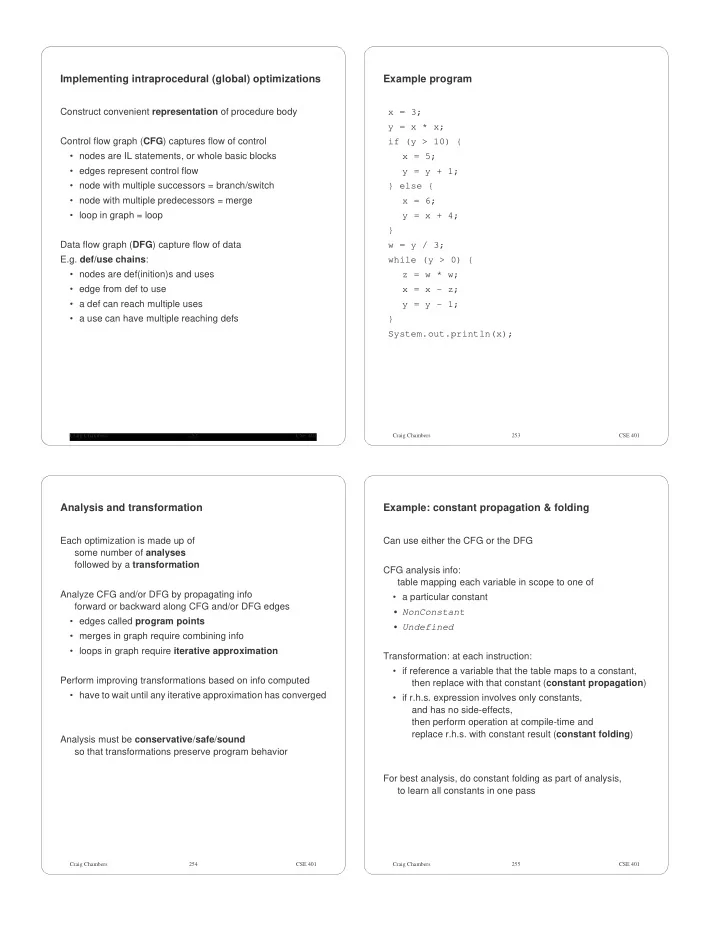

Implementing intraprocedural (global) optimizations Example program Construct convenient representation of procedure body x = 3; y = x * x; Control flow graph ( CFG ) captures flow of control if (y > 10) { x = 5; • nodes are IL statements, or whole basic blocks y = y + 1; • edges represent control flow } else { • node with multiple successors = branch/switch x = 6; • node with multiple predecessors = merge y = x + 4; • loop in graph = loop } Data flow graph ( DFG ) capture flow of data w = y / 3; E.g. def/use chains : while (y > 0) { z = w * w; • nodes are def(inition)s and uses x = x - z; • edge from def to use y = y - 1; • a def can reach multiple uses } • a use can have multiple reaching defs System.out.println(x); Craig Chambers 252 CSE 401 Craig Chambers 253 CSE 401 Analysis and transformation Example: constant propagation & folding Each optimization is made up of Can use either the CFG or the DFG some number of analyses followed by a transformation CFG analysis info: table mapping each variable in scope to one of Analyze CFG and/or DFG by propagating info • a particular constant forward or backward along CFG and/or DFG edges • NonConstant • edges called program points • Undefined • merges in graph require combining info • loops in graph require iterative approximation Transformation: at each instruction: • if reference a variable that the table maps to a constant, Perform improving transformations based on info computed then replace with that constant ( constant propagation ) • have to wait until any iterative approximation has converged • if r.h.s. expression involves only constants, and has no side-effects, then perform operation at compile-time and replace r.h.s. with constant result ( constant folding ) Analysis must be conservative / safe / sound so that transformations preserve program behavior For best analysis, do constant folding as part of analysis, to learn all constants in one pass Craig Chambers 254 CSE 401 Craig Chambers 255 CSE 401
Example program Merging data flow analysis info x = 3; How to merge analysis info? y = x * x; v = y - 2; Constraint: merge results must be sound if (z > 10) { • if something is believed true after the merge, then it must be true no matter which path we took into the x = 5; merge y = y + 1; • only things true along all predecessors are true after the } else { merge y = x + 4; } To merge two maps of constant info, w = y / v; build map by merging corresponding variable infos if (v > 20) { v = x - 1; To merge two variable infos: } • if one is Undefined , keep the other u = x + v; • if both same constant, keep that constant • otherwise, degenerate to NonConstant Craig Chambers 256 CSE 401 Craig Chambers 257 CSE 401 Analysis of loops Some loop terminology How to analyze a loop? preheader i = 0; entry edge x = 10; y = 20; while (...) { head // what’s true here? ... i = i + 1; y = 30; } loop // what’s true here? ... x ... i ... y ... back edge tail A safe but imprecise approach: • forget everything when we enter or exit a loop exit edge A precise but unsafe approach: • keep everything when we enter or exit a loop Can we do better? Craig Chambers 258 CSE 401 Craig Chambers 259 CSE 401
Optimistic iterative analysis Example i = 0; 1. Assuming info at loop head is same as info at loop entry x = 10; y = 20; 2. Then analyze loop body, computing info at back edge while (...) { // what’s true here? 3. Merge infos at loop back edge and loop entry ... i = i + 1; 4. Test if merged info is same as original assumption y = 30; } a. If so, then we’re done // what’s true here? ... x ... i ... y ... b. If not, then replace previous assumption with merged info, and goto step 2 Craig Chambers 260 CSE 401 Craig Chambers 261 CSE 401 Why does optimistic iterative analysis work? Another example: live variables analysis Want the set of variables that are live at each pt. in program Why are the results always conservative? Because if the algorithm stops, then • live: might be used later in the program • the loop head info is at least as conservative as both the Supports dead assignment elimination, register allocation loop entry info and the loop back edge info • the analysis within the loop body is conservative, given the What info computed for each program point? assumption that the loop head info is conservative What is the requirement for this info to be conservative? Why does the algorithm terminate? It might not! But it does if: How to merge two infos conservatively? • there are only a finite number of times we could merge values together without reaching the worst case info (e.g. NotConstant ) How to analyze an assignment, e.g. X := Y + Z ? • given liveVars before (or after?), what is computed after (or before?) What is live at procedure entry (or exit?)? Craig Chambers 262 CSE 401 Craig Chambers 263 CSE 401
Example x := 5 y := x * 2 x := x + 1 y := x + 10 ... y ... Craig Chambers 264 CSE 401
Recommend
More recommend